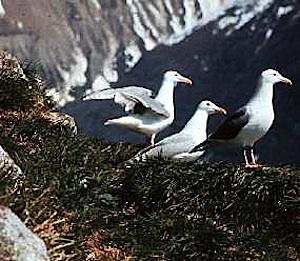A law authorizing the Huna Tlingit to harvest glaucous-winged gull eggs in their traditional homeland of Glacier Bay National Park and Preserve in Alaska has been signed by President Obama.
The president signed the legislation on July 25. Both the National Park Service and the Hoonah Indian Association, the federally recognized tribe of the Huna Tlingit, testified before Congress on behalf of the legislation earlier this year. The final step to implement the law is the promulgation of regulations required to allow HIA tribal members to collect the gull eggs at rookeries under a harvest plan to be developed annually by the National Park Service and and the tribe.
“The passage of this legislation is integral to conserving the Xuna Kawoo as a living community whose continued existence requires the sustainable management of the resources on which it depends," said Bob Starbard, the association's tribal administrator. "The tribe looks forward to working cooperatively and collaboratively with the National Park Service in development of agency-specific regulations necessary to achieve a sustainable harvest.”
Gull eggs are an important traditional spring food source for the Huna Tlingit. Family harvest trips once served as a mechanism for maintaining ties with homeland and transmitting stories, moral codes, and cultural traditions to the younger generation, according to a Park Service release. In particular, the islands in lower Glacier Bay called K'wát' Aaní (Land of the Seagull Eggs) are thought to produce richer, more abundant, and tastier eggs than elsewhere. Gull egg harvest was curtailed in Glacier Bay in the mid-20th century as the activity was prohibited by the Migratory Bird Treaty Act and National Park Service regulations.
The Service began exploring options for authorizing gull egg harvest when Huna tribal elders described the tradition at a consultation meeting in 1997.
“The elders explained that gull eggs were far more than a nutritious food source for the Huna clans,” said Mary Beth Moss, cultural anthropologist at Glacier Bay. “Gull egg collection signaled the beginning of a new year of seasonal harvest rounds. Harvest trips provided opportunities for families to bond; served as a context in which Tlingit values, morals and ethics could be passed down to youth; tied the Huna Tlingit to their beloved homeland of Glacier Bay; and served as a unique element in the Huna tribes’ identity.”
NPS staff and Department of Interior solicitors recognized there were numerous legal hurdles to overcome before a harvest could occur, including analyzing the effects of harvest activities as required by the National Environmental Policy Act (NEPA), passing legislation to authorize a harvest, and promulgating regulations to implement such legislation.
NPS initiated ethnographic and biological studies in 1999; later passage of the Glacier Bay National Park Resource Management Act of 2000 provided additional direction for NPS to assess whether sea gull eggs could be collected in the park on a limited basis without impairing the biological sustainability of the gull population. The Act further required the Secretary to submit recommendations for legislation to Congress if the study determined that collecting could occur without impairment in the park. A team of biologists, cultural specialists, and tribal members subsequently prepared the required Legislative Environmental Impact Statement which analyzed various harvest alternatives and identified a preferred harvest program. This cooperatively developed harvest strategy forms the basis of Senate Bill 156’s language.
Similar legislation was first introduced by Senators Lisa Murkowski and Mark Begich and Representative Don Young in 2011, but S.B 1063 and H.R. 3037 languished on Congressional dockets. The slightly revised language captured in S.B 156 and H.R. 3110 clarifies how harvest could occur in Glacier Bay – a park where subsistence activities are not authorized.
Because the Alaska National Interests Lands Conservation Act (ANILCA) does not authorize subsistence activities in parks established before the Act’s passage – including Glacier Bay – the NPS and HIA have worked together for decades to explore options for maintaining and facilitating traditional uses – including food gathering – through other mechanisms. Through a Memorandum of Understanding, the partners have developed a range of ongoing programs including annually sponsored ceremonial and food gathering trips, the development of culturally responsive school curricula and summer camps, and the construction of a 2,500 square foot tribal house on the shores of Bartlett Cove.
"The park will now be able to focus on a regulatory package to implement this important aspect of Huna Tlingit cultural heritage while maintaining seabird populations and protecting other park purposes and values," said Glacier Bay Superintendent Philip Hooge. "This regulation will need to have the flexibility to authorize egg collection within the changing landscape that defines Glacier Bay.”




Add comment